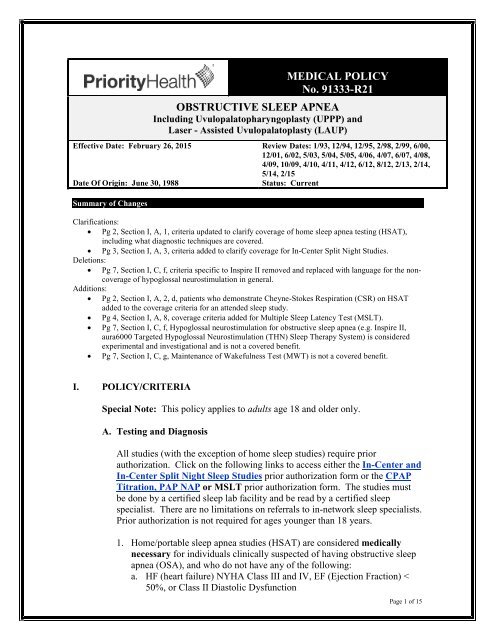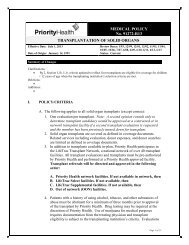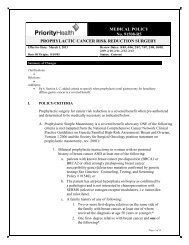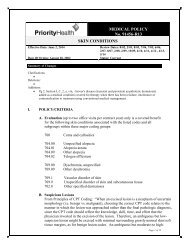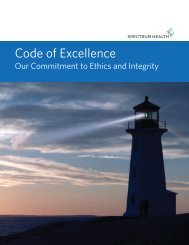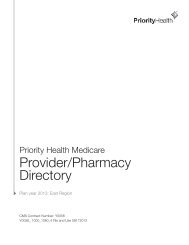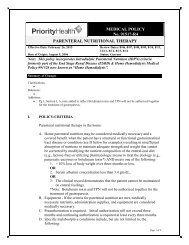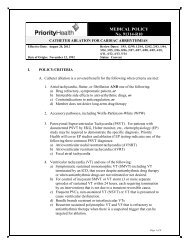Obstructive Sleep Apnea and Upper Airway ... - Priority Health
Obstructive Sleep Apnea and Upper Airway ... - Priority Health
Obstructive Sleep Apnea and Upper Airway ... - Priority Health
Create successful ePaper yourself
Turn your PDF publications into a flip-book with our unique Google optimized e-Paper software.
MEDICAL POLICYNo. 91333-R21OBSTRUCTIVE SLEEP APNEAIncluding Uvulopalatopharyngoplasty (UPPP) <strong>and</strong>Laser - Assisted Uvulopalatoplasty (LAUP)Effective Date: February 26, 2015 Review Dates: 1/93, 12/94, 12/95, 2/98, 2/99, 6/00,12/01, 6/02, 5/03, 5/04, 5/05, 4/06, 4/07, 6/07, 4/08,4/09, 10/09, 4/10, 4/11, 4/12, 6/12, 8/12, 2/13, 2/14,5/14, 2/15Date Of Origin: June 30, 1988Status: CurrentSummary of ChangesClarifications:• Pg 2, Section I, A, 1, criteria updated to clarify coverage of home sleep apnea testing (HSAT),including what diagnostic techniques are covered.• Pg 3, Section I, A, 3, criteria added to clarify coverage for In-Center Split Night Studies.Deletions:• Pg 7, Section I, C, f, criteria specific to Inspire II removed <strong>and</strong> replaced with language for the noncoverageof hypoglossal neurostimulation in general.Additions:• Pg 2, Section I, A, 2, d, patients who demonstrate Cheyne-Stokes Respiration (CSR) on HSATadded to the coverage criteria for an attended sleep study.• Pg 4, Section I, A, 8, coverage criteria added for Multiple <strong>Sleep</strong> Latency Test (MSLT).• Pg 7, Section I, C, f, Hypoglossal neurostimulation for obstructive sleep apnea (e.g. Inspire II,aura6000 Targeted Hypoglossal Neurostimulation (THN) <strong>Sleep</strong> Therapy System) is consideredexperimental <strong>and</strong> investigational <strong>and</strong> is not a covered benefit.• Pg 7, Section I, C, g, Maintenance of Wakefulness Test (MWT) is not a covered benefit.I. POLICY/CRITERIASpecial Note: This policy applies to adults age 18 <strong>and</strong> older only.A. Testing <strong>and</strong> DiagnosisAll studies (with the exception of home sleep studies) require priorauthorization. Click on the following links to access either the In-Center <strong>and</strong>In-Center Split Night <strong>Sleep</strong> Studies prior authorization form or the CPAPTitration, PAP NAP or MSLT prior authorization form. The studies mustbe done by a certified sleep lab facility <strong>and</strong> be read by a certified sleepspecialist. There are no limitations on referrals to in-network sleep specialists.Prior authorization is not required for ages younger than 18 years.1. Home/portable sleep apnea studies (HSAT) are considered medicallynecessary for individuals clinically suspected of having obstructive sleepapnea (OSA), <strong>and</strong> who do not have any of the following:a. HF (heart failure) NYHA Class III <strong>and</strong> IV, EF (Ejection Fraction)
MEDICAL POLICYNo. 91333-R21<strong>Obstructive</strong> <strong>Sleep</strong> <strong>Apnea</strong>Including UPPP <strong>and</strong> LAUPb. Cardiac arrhythmia (e.g. atrial fibrillation, SVT, ventriculararrhythmia)c. History of myocardial infarction or coronary artery disease in last 12monthsd. Moderate to severe pulmonary disease (e.g., chronic respiratorydisease / symptomatic lung disease / pulmonary hypertension)e. Neuromuscular diseasef. Stroke or TIA within the last 12 monthsg. Cognitive impairment, behavioral health issues or other socialcircumstances that compromise administration of a home sleep test(HST)h. Seizure disorderPrior authorization is not required for home sleep apnea studies <strong>and</strong> maybe ordered by any licensed physician or advanced practice provider.In addition to meeting criteria in #1 above, evaluation using HSAT iscovered if clinical interpretation is performed by a board certified sleepspecialist <strong>and</strong> HSAT is provided by Medicare certified participatingprovider with a device described below.Unattended (home) sleep studies using any of the following diagnostictechniques is medically necessary for members with symptoms suggestiveof OSA when the home sleep study is used as part of a comprehensivesleep evaluation:a. <strong>Sleep</strong> monitoring using a Type II device, orb. <strong>Sleep</strong> monitoring using a Type III device, orc. <strong>Sleep</strong> monitoring using a Type IV(A) device, measuring airflow <strong>and</strong> atleast 2 other channels <strong>and</strong> providing measurement of apnea-hypopneaindex (AHI)Note: <strong>Sleep</strong> studies using devices that do not provide a measurement ofapnea-hypopnea index (AHI) <strong>and</strong> oxygen saturation are considered notmedically necessary because they do not provide sufficient information toprescribe treatment. Examples include the Biancamed <strong>Sleep</strong>Minder,SNAP testing with fewer than three channels, <strong>and</strong> the <strong>Sleep</strong>Image <strong>Sleep</strong>Quality Screener. Note that the <strong>Apnea</strong>Link does not meet criteria as acovered type IV device because it does not measure airflow; however, the<strong>Apnea</strong>Link Plus records 5 channels, including airflow, <strong>and</strong> meets criteriafor a covered sleep study device.2. Attended sleep studies or polysomnogram (PSG) may be consideredmedically necessary for individuals with suspected OSA as determinedby clinical symptoms <strong>and</strong> one of the following:a. Any of the clinical symptoms outlined in (a - h) in 1 above; orPage 2 of 15
MEDICAL POLICYNo. 91333-R21<strong>Obstructive</strong> <strong>Sleep</strong> <strong>Apnea</strong>Including UPPP <strong>and</strong> LAUPb. Two failed, incomplete, or inadequate HSATs with significantindicators of OSA; orc. One technically complete or adequate negative HSAT with highsuspicion of OSA (presumptive false negative); ord. On patients who demonstrate Cheyne-Stokes Respiration (CSR) onHSAT; ore. Individual currently being treated with a dental appliance withmoderate to severe OSA (AHI>15) at baseline.3. Emergency criteria to allow for Split Night Studies:In the event that moderate to severe OSA was not anticipated prior toordering PSG, <strong>and</strong> to ensure safety during PSG, conversion to a SplitNight Study is considered medically necessary if all criteria below aremet:a. OSA is diagnosed by AHI as defined below on PSG.b. Oxygen desaturation as defined by SaO 2 45, <strong>and</strong>hypoventilation with documented hypoxia5. Repeat facility-based PSG are a covered benefit when the above criteriain #2 for a PSG are met or for evaluation of one of the following:a. the discontinuation of PAP or oral appliance after surgery; orb. resolution of OSA after surgical treatment for OSA; orPage 3 of 15
MEDICAL POLICYNo. 91333-R21<strong>Obstructive</strong> <strong>Sleep</strong> <strong>Apnea</strong>Including UPPP <strong>and</strong> LAUPc. resolution of OSA following significant weight loss such as thatassociated with bariatric surgery6. CPAP Titration Studies may be covered if any of the following criteria arepresent:• Moderate to severe pulmonary disease (e.g. chronic respiratorydisease / symptomatic lung disease / pulmonary hypertension)• Congestive heart failure or recent MI within the last 6 months• Cognitive impairment that compromises administration of a homeapnea sleep test (HSAT)• OSA with severe desaturation (oxygen desaturations either a) >5continuous minutes with SaO 2
MEDICAL POLICYNo. 91333-R21<strong>Obstructive</strong> <strong>Sleep</strong> <strong>Apnea</strong>Including UPPP <strong>and</strong> LAUPb. <strong>Apnea</strong>/Hypopnea Index (AHI) >15 on attended polysomnography; orc. AHI > 5 <strong>and</strong> < 15 on attended PSG AND one or more of the followingare met:• Excessive daytime sleepiness documented by either Epworth<strong>Sleep</strong>iness Scale > 10 or Multiple <strong>Sleep</strong> Latency Test (MSLT)< 8, or documented drowsiness while driving• Documented impaired cognition or workplace performance• Mood disorders under medical pharmacologic or psychiatricintervention• Hypertension requiring pharmacologic management• History of ischemic heart disease, stroke/TIA, or arrhythmias2. Covered treatment modalities for OSA that meets criteria 1a, 1b or 1cabove include:a. Auto-titrating positive airway pressure (APAP), orb. Continuous Positive <strong>Airway</strong> Pressure (CPAP) if medically indicated.• BiPAP, DPAP, <strong>and</strong> VPAP are covered as DME for patients ifabove criteria for CPAP are met <strong>and</strong> a previous trial of CPAPhas failed. These alternatives to CPAP may also be covered forOSA patients with concomitant breathing disorders, whichinclude restrictive thoracic disorders, COPD, <strong>and</strong> nocturnalhypoventilation.• Humidifiers <strong>and</strong> heaters for positive airway pressure devicesare covered.• A nasal/face mask or an oral pressure appliance ( Oral Positive<strong>Airway</strong> Pressure - OPAP) are covered as durable medicalequipment.c. Continued coverage of a PAP device for a second three month trial ofthe equipment requires a re-evaluation by the treating physician withdocumentation by that physician of the re-education of the member onthe use of PAP equipment.NOTE: PAP requests should be submitted on the CPAP prior authorizationform (please click to link to form).d. Oral Appliance. Covered under Prosthetics <strong>and</strong> Orthotics benefitlevel, applicable copays apply.e. *Uvulopalatopharyngoplasty (UPPP), uvulectomy, or any otherprocedures to correct obstructive sleep apnea, are covered benefits ifboth of the following apply:i. <strong>Obstructive</strong> <strong>Sleep</strong> <strong>Apnea</strong> (OSA)ii. Respiratory Disturbance Index (RDI) or <strong>Apnea</strong>/Hypopnea Index(AHI) is 15 or greater on polysomnography, or two or more of thefollowing are met:• AHI>5 <strong>and</strong>
MEDICAL POLICYNo. 91333-R21<strong>Obstructive</strong> <strong>Sleep</strong> <strong>Apnea</strong>Including UPPP <strong>and</strong> LAUP• >20 episodes of oxygen desaturation < 85% or any oneepisode of oxygen desaturation < 70%• Type II second degree heart block or pause > 3 seconds orventricular tachycardia at a rate > 140/minute lasting > 15complexes• Excessive daytime sleepiness documented by eitherEpworth <strong>Sleep</strong>iness Scale > 10 or Multiple <strong>Sleep</strong> LatencyTest (MSLT) < 8*A three (3) month trial of CPAP must be completed prior to UPPP.UPPP is a surgical procedure in which the oropharynx is enlarged byexcision of the uvula <strong>and</strong> tissue of the soft palate. A tonsillectomymay also be done with the UPPP; payment for the tonsillectomy willbe considered incidental to the more comprehensive UPPP procedure.UPPP, when medically necessary, is a covered benefit.C. The following are not covered benefits (this list is not all-inclusive):a. Laser - Assisted Uvulopalatoplasty (LAUP). LAUP has not beenproven to be an appropriate or effective treatment of OSA or UARS. (Thetreatment of snoring by LAUP is not a covered benefit.)b. Radiofrequency Ablation of the tongue base, uvula or soft palate(Somnoplasty) or of the nasal passages <strong>and</strong> soft palate (Coblation) isconsidered experimental <strong>and</strong> investigational as a treatment for obstructivesleep apnea because there is inadequate scientific evidence to validate theeffectiveness of these procedures for this indication.c. Pillar Procedure. There is a lack of evidence of short-term or long-termeffectiveness of palatal restoration, or Pillar Procedure when performedfor either obstructive sleep apnea or snoring. Palatal implant is covered forMedicare patients who meet certain Medicare criteria.d. Tongue-base suspension (i.e., Repose). The suspension of the anteriortongue by fixation of the soft tissue to the m<strong>and</strong>ible using a bone screw isconsidered to be experimental <strong>and</strong> investigational.e. Partial Glossectomy surgical removal of a portion of the tongue or oralcavity in an effort to widen the hypopharynx is considered to beexperimental <strong>and</strong> investigational.f. Hypoglossal neurostimulation for obstructive sleep apnea (e.g. Inspire II,aura6000 Targeted Hypoglossal Neurostimulation (THN) <strong>Sleep</strong> TherapySystem) is considered experimental <strong>and</strong> investigationalg. Maintenance of Wakefulness Test (MWT) objectively measures theability of an individual to remain awake for a defined period of time.Although the MWT has been used to evaluate the risk for driving, work,or home-related accidents, its validity for this purpose has not been proven<strong>and</strong> is not a covered benefit.Definitions:Page 6 of 15
MEDICAL POLICYNo. 91333-R21<strong>Obstructive</strong> <strong>Sleep</strong> <strong>Apnea</strong>Including UPPP <strong>and</strong> LAUPThe AHI is determined by attended polysomnography, equal to the total numberor apneas <strong>and</strong> hypopneas x 60 divided by the total sleep time in minutes. <strong>Apnea</strong>is scored if airflow is reduced by >90% for at least 10 seconds. Hypopneas arescored if there is a drop by >30% of pre-event baseline airflow lasting at least 10seconds, resulting in an EEG arousal or >3% oxyhemoglobin desaturation.The RDI is equal to the average number of episodes of apnea <strong>and</strong> hypopneaevents per hour of recording <strong>and</strong> must be based on a minimum of 2 hours of timerecorded by unattended polysomnography. <strong>Apnea</strong> is defined as a cessation ofairflow for at least 10 seconds. Hypopnea is defined as an abnormal respiratoryevent lasting at least 10 seconds with at least a 30% reduction in airflow ascompared to baseline, resulting in at least a 3% oxyhemoglobin desaturation.If the AHI or RDI is calculated based on less than 2 hours of sleep or recordingtime, the total number of recorded events used to calculated the AHI or RDI(respectively) must be at least the number of events that would have been requiredin a 2 hour period (i.e., must reach >30 events without symptoms or >10 eventswith symptoms).II.MEDICAL NECESSITY REVIEWRequired - for in-center sleep testing <strong>and</strong> capped rental positive pressureappliances (see below)Not Required – for home sleep testing, surgery; PAP supplies <strong>and</strong> oralappliances - unless DME/P&O dollar threshold exceeded (greater than $1,000;$500 for <strong>Priority</strong> <strong>Health</strong> Medicaid).Not ApplicableIII.APPLICATION TO PRODUCTSCoverage is subject to member’s specific benefits. Group specific policy willsupersede this policy when applicable. HMO/EPO: This policy applies to insured HMO/EPO plans. POS: This policy applies to insured POS plans. PPO: This policy applies to insured PPO plans. Consult individual plan documents asstate m<strong>and</strong>ated benefits may apply. If there is a conflict between this policy <strong>and</strong> a pl<strong>and</strong>ocument, the provisions of the plan document will govern. ASO: For self-funded plans, consult individual plan documents. If there is a conflictbetween this policy <strong>and</strong> a self-funded plan document, the provisions of the plan documentwill govern. INDIVIDUAL: For individual policies, consult the individual insurance policy. If there isa conflict between this medical policy <strong>and</strong> the individual insurance policy document, theprovisions of the individual insurance policy will govern. MEDICARE: Coverage is determined by the Centers for Medicare <strong>and</strong> Medicaid Services(CMS); if a coverage determination has not been adopted by CMS, this policy applies.Page 7 of 15
MEDICAL POLICYNo. 91333-R21<strong>Obstructive</strong> <strong>Sleep</strong> <strong>Apnea</strong>Including UPPP <strong>and</strong> LAUP MEDICAID/HEALTHY MICHIGAN PLAN: For Medicaid/<strong>Health</strong>y Michigan Planmembers, this policy will apply. Coverage is based on medical necessity criteria being met<strong>and</strong> the appropriate code(s) from the coding section of this policy being included on theMichigan Medicaid Fee Schedule located at: http://www.michigan.gov/mdch/0,1607,7-132-2945_42542_42543_42546_42551-159815--,00.html. If there is a discrepancy betweenthis policy <strong>and</strong> the Michigan Medicaid Provider Manual located at:http://www.michigan.gov/mdch/0,1607,7-132-2945_5100-87572--,00.html, the MichiganMedicaid Provider Manual will govern. For Medical Supplies/DME/Prosthetics <strong>and</strong>Orthotics, please refer to the Michigan Medicaid Fee Schedule to verify coverage. MICHILD: For MICHILD members, this policy will apply unless MICHILD certificate ofcoverage limits or extends coverage.IV.DESCRIPTION<strong>Obstructive</strong> <strong>Sleep</strong> <strong>Apnea</strong> (OSA) is characterized by the collapse <strong>and</strong> obstructionof the upper airway during sleep, leading to sleep fragmentation. In thissyndrome, respiratory efforts persist but are ineffective due to obstruction thatmay occur anywhere in the upper airway. The most common complaintsassociated with OSA are snoring <strong>and</strong> excessive daytime sleepiness. Snoring,although it may be a social problem, is not a medical condition. The treatment ofsnoring alone is not a covered benefit. There must be objective evidence of sleepapnea on polysomnography or Multiple <strong>Sleep</strong> Latency Test for coverage oftreatment. Testing for OSA is a covered benefitSt<strong>and</strong>ard Classifications of OSAS according to <strong>Apnea</strong>/Hypopnea Index (AHI)Mild greater than 5 <strong>and</strong> less than 15Moderate: 15 to 30Severe: greater than 30The diagnosis of sleep apnea may require confirmation by sleep laboratorystudies. Patients’ symptoms <strong>and</strong> the frequency of respiratory events on laboratorytesting are important factors in determining the severity of disease. In patientswith mild sleep apnea, conservative treatment measures include getting sufficientsleep, abstaining from the use of alcohol, tobacco, <strong>and</strong> sedatives, losing weight,<strong>and</strong> avoiding the supine position during sleep. Many patients with documentedsleep apnea require more than conservative therapy. Continuous positive airwaypressure (CPAP) is the most consistently effective treatment for clinicallysignificant obstructive sleep apnea.Palatal surgical procedures tend to alleviate snoring but are not consistentlyeffective in treating sleep apnea. Many patients with sleep apnea have airwayobstruction beyond the palatal area that is not treated by soft tissue procedures.15V. CODING INFORMATIONPage 8 of 15
MEDICAL POLICYNo. 91333-R21<strong>Obstructive</strong> <strong>Sleep</strong> <strong>Apnea</strong>Including UPPP <strong>and</strong> LAUPICD-9 Codes that may apply (for dates of service on or before September 30, 2015):(List should not be considered inclusive):<strong>Sleep</strong> Testing – in center:327.10 Organic hypersomnia, unspecified327.11 Idiopathic hypersomnia with long sleep time327.12 Idiopathic hypersomnia without long sleep time327.13 Recurrent hypersomnia327.20 – 327.29 Organic <strong>Sleep</strong> <strong>Apnea</strong>327.40 – 327.49 Organic parasomnia347.00 – 347.11 Cataplexy <strong>and</strong> narcolepsy780.50 <strong>Sleep</strong> disturbance, unspecified780.51 Insomnia with sleep apnea, unspecified780.53 Hypersomnia with sleep apnea, unspecified780.54 Hypersomnia, unspecified780.57 Unspecified sleep apnea780.59 <strong>Sleep</strong> Disturbance, other786.09 Other dyspnea <strong>and</strong> respiratory abnormalitiesICD-10 Codes that may apply (for dates of service on or after October 1, 2015):G47.10 – G47.19 HypersomniaG47.30 <strong>Sleep</strong> apnea, unspecifiedG47.31 Primary central sleep apneaG47.33 <strong>Obstructive</strong> sleep apnea (adult) (pediatric)G47.34 Idiopathic sleep related nonobstructive alveolar hypoventilationG47.35 Congenital central alveolar hypoventilation syndromeG47.36 <strong>Sleep</strong> related hypoventilation in conditions classified elsewhereG47.37 Central sleep apnea in conditions classified elsewhereG47.39 Other sleep apneaG47.411 – G47.429 NarcolepsyG47.50 – G47.59 ParasomniaG47.8 Other sleep disordersG47.9 <strong>Sleep</strong> disorder, unspecifiedR06.00 Dyspnea, unspecifiedR06.09 Other forms of dyspneaR06.3 Periodic breathingR06.83 SnoringR06.89 Other abnormalities of breathingCovered CPT/HCPCS Codes when policy criteria met:Limitations apply for <strong>Priority</strong> <strong>Health</strong> Medicare – see LCDHome <strong>Sleep</strong> Studies95800 <strong>Sleep</strong> study, unattended, simultaneous recording; heart rate, oxygen saturation,respiratory analysis (eg, by airflow or peripheral arterial tone), <strong>and</strong> sleep time95801 <strong>Sleep</strong> study, unattended, simultaneous recording; minimum of heart rate,oxygen saturation, <strong>and</strong> respiratory analysis (eg, by airflow or peripheral arterialtone)Page 9 of 15
MEDICAL POLICYNo. 91333-R21<strong>Obstructive</strong> <strong>Sleep</strong> <strong>Apnea</strong>Including UPPP <strong>and</strong> LAUP95806 <strong>Sleep</strong> study, simultaneous recording of ventilation, respiratory effort, ECG orheart rate, <strong>and</strong> oxygen saturation, unattended by a technologist (Not coveredfor <strong>Priority</strong> Medicaid)G0398 Home sleep study test (HST) with type II portable monitor, unattended;minimum of 7 channels: EEG, EOG, EMG, ECG/heart rate, airflow,respiratory effort <strong>and</strong> oxygen saturation (Not covered for <strong>Priority</strong> Medicaid)G0399 Home sleep test (HST) with type III portable monitor, unattended; minimum of4 channels: 2 respiratory movement/airflow, 1 ECG/heart rate <strong>and</strong> 1oxygensaturation (Not covered for <strong>Priority</strong> Medicaid)G0400 Home sleep test (HST) with type IV portable monitor, unattended; minimum of3 channels (Not covered for <strong>Priority</strong> Medicaid)In Center <strong>Sleep</strong> Studies – Prior Authorization (PA) required(PA not required for members 0 – 18 years)95807 <strong>Sleep</strong> study, simultaneous recording of ventilation, respiratory effort, ECG orheart rate, <strong>and</strong> oxygen saturation, attended by a technologistAppend modifier 52 for PAP NAP billing95808 Polysomnography; any age, sleep staging with 1-3 additional parameters ofsleep, attended by a technologist95810 Polysomnography; age 6 years or older, sleep staging with 4 or more additionalparameters of sleep, attended by a technologist95811 Polysomnography; age 6 years or older, sleep staging with 4 or more additionalparameters of sleep, with initiation of continuous positive airway pressuretherapy or bi-level ventilation, attended by a technologist95805 Multiple sleep latency or maintenance of wakefulness testing, recording,analysis <strong>and</strong> interpretation of physiological measurements of sleep duringmultiple trials to assess sleepinessNo prior authorization required:94660 Continuous positive airway pressure ventilation (CPAP), initiation <strong>and</strong>managementConsultation with a registered respiratory therapist or registeredpolysomnographic technologist at the time of initial treatment <strong>and</strong> or duringor immediately after the initial 90 days of treatment with any of the PAPtherapy devices to ensure appropriate use <strong>and</strong> fit of equipment <strong>and</strong> associateddevices will be covered.95782 Polysomnography; younger than 6 years, sleep staging with 4 or moreadditional parameters of sleep, attended by a technologist95783 Polysomnography; younger than 6 years, sleep staging with 4 or moreadditional parameters of sleep, with initiation of continuous positive airwaypressure therapy or bi-level ventilation, attended by a technologistCheck plan benefit limitations for surgical services42140 Uvulectomy, excision of uvula42145 Palatopharyngoplasty (eg, uvulopalatopharyngoplasty, uvulopharyngoplasty)Page 10 of 15
MEDICAL POLICYNo. 91333-R21<strong>Obstructive</strong> <strong>Sleep</strong> <strong>Apnea</strong>Including UPPP <strong>and</strong> LAUPICD-9 Code that is payable for the following codes (for dates of service on or beforeSeptember 30, 2015):327.23 <strong>Obstructive</strong> sleep apnea (adult) (pediatric)ICD-10 Code that is payable for the following codes (for dates of service on or afterOctober 1, 2015):G47.33 <strong>Obstructive</strong> sleep apnea (adult) (pediatric)CPT/HCPCS Codes:E0485 Oral device/appliance used to reduce upper airway collapsibility, adjustable ornon-adjustable, prefabricated, includes fitting <strong>and</strong> adjustment(Not covered for <strong>Priority</strong> Medicaid or Medicare)E0486 Oral device/appliance used to reduce upper airway collapsibility, adjustable ornon-adjustable, custom fabricated, includes fitting <strong>and</strong> adjustment(Not covered for <strong>Priority</strong> Medicaid)Authorization required for all plans• Capped rental; DME benefit• Prior Authorization waived one time for the 1 st three months rental. If treatmentis not continued after 3 months but is resumed at a later time, prior authorizationwill be required from the start of treatment for the first 3 months <strong>and</strong> to continuefor the following 7 months (10 months for Medicare) of the capped rental period.• Requests for prior authorization must include evidence of compliance defined asuse of PAP ≥4 hours per night for a minimum of 21 nights (70% of nights) duringa consecutive thirty (30) day period anytime during the first three (3) months ofusage.E0470E0471E0472E0601Respiratory assist device, bi-level pressure capability, without backup ratefeature, used with noninvasive interface, e.g., nasal or facial mask (intermittentassist device with continuous positive airway pressure device)Respiratory assist device, bi-level pressure capability, with backup rate feature,used with noninvasive interface, e.g., nasal or facial mask (intermittent assistdevice with continuous positive airway pressure device)Respiratory assist device, bi-level pressure capability, with backup rate feature,used with noninvasive interface, e.g., tracheostomy tube (intermittent assistdevice with continuous positive airway pressure device) (Not covered for<strong>Priority</strong> Medicaid)Continuous airway pressure (CPAP) deviceNon-covered CPT/HCPCS Codes:95803 Actigraphy testing, recording, analysis, interpretation, <strong>and</strong> report (minimum of72 hours to 14 consecutive days of recording)41120 Glossectomy; less than 1/2 tongue (not covered for sleep related conditions)41130 Glossectomy; hemiglossectomy (not covered for sleep related conditions)41512 Tongue base suspension, permanent suture technique41530 Submucosal ablation of the tongue base, radiofrequency, 1 or more sites, persessionPage 11 of 15
MEDICAL POLICYNo. 91333-R21<strong>Obstructive</strong> <strong>Sleep</strong> <strong>Apnea</strong>Including UPPP <strong>and</strong> LAUP42160 Destruction of lesion, palate or uvula (thermal, cryo or chemical) (coveredfor non-sleep related indications with prior auth)42299 Unlisted procedure, palate, uvula (Not covered if billed for somnoplasty or anyother not covered procedure. Explanatory notes must accompany claim)C9727S2080E0190E1399Insertion of implants into the soft palate; minimum of three implantsLaser-assisted uvulopalatoplasty (LAUP)Positioning cushion/pillow/wedge, any shape or size, includes all components<strong>and</strong> accessoriesDurable medical equipment, miscellaneous (Explanatory notes mustaccompany claim)Not covered for devices such as Provent® <strong>and</strong>/or other devices not recognizedas covered in this policy.VI.REFERENCESComplete Guide to Medicare Coverage Issues, Centers for Medicare <strong>and</strong>Medicaid, National Coverage Determinations Manual (Pub. 100-03, 2-88),National Coverage Decision (NCD) 240.4, Continuous Positive airwayPressure (CPAP) Therapy for <strong>Obstructive</strong> <strong>Sleep</strong> <strong>Apnea</strong> (OSA), Effectivedate: April 4, 2005, E0601, E0407-E0472, Ingenix, Inc., May 2006.Complete Guide to Medicare Coverage Issues, Centers for Medicare <strong>and</strong>Medicaid, Medicare Benefit Policy Manual (Pub. 100-02), Chapter 6, 50 –<strong>Sleep</strong> Disorders Clinics, Ingenix, Inc., May 2006.<strong>Obstructive</strong> <strong>Sleep</strong> <strong>Apnea</strong>, Diagnosis <strong>and</strong> Treatment, Coverage Policy Bulletin,Aetna US <strong>Health</strong>care, 2000-2001.Surgical Management of <strong>Obstructive</strong> <strong>Sleep</strong> <strong>Apnea</strong> Syndrome <strong>and</strong> <strong>Upper</strong> <strong>Airway</strong>Resistance Syndrome, Medical Policy Manual, The Regence Group, April2001.Centers for Medicare <strong>and</strong> Medicaid (CMS) Coverage Database, NationalCoverage Determination (NCD), NCD for Continuous Positive <strong>Airway</strong>Pressure (CPAP) Therapy for <strong>Obstructive</strong> <strong>Sleep</strong> <strong>Apnea</strong> (OSA) (240.4), Pub.100-3, Effective date: 04/04/2005.Centers for Medicare <strong>and</strong> Medicaid (CMS) Manual System, Pub. 100-03,Medicare National Coverage Determination (NCD) Continuous Positive<strong>Airway</strong> Pressure (CPAP) Therapy for <strong>Obstructive</strong> <strong>Sleep</strong> <strong>Apnea</strong> (OSA),CR#3843, May 6, 2005, (Retrieved 3/15/2007)http://www.cms.hhs.gov/transmittals/downloads/R35NCD.pdf.Restore Medical. Available on the World Wide Web @http://www.pillarprocedure.com/ (Retrieved April 26, 2005)Page 12 of 15
MEDICAL POLICYNo. 91333-R21<strong>Obstructive</strong> <strong>Sleep</strong> <strong>Apnea</strong>Including UPPP <strong>and</strong> LAUPPortable Devices for home testing for obstructive sleep apnea – CaliforniaTechnology Assessment Forum June 15, 2005Wisconsin Physicians Service (WPS), National Coverage Provision (NCP),Surgical Treatment of <strong>Obstructive</strong> <strong>Sleep</strong> <strong>Apnea</strong>, ENT-012, Michiganeffective date: 07/01/2002, Revision effective date: 10/01/2006Wisconsin Physicians Service (WPS), National Coverage Provision (NCP), <strong>Sleep</strong>-Disorder Clinics <strong>and</strong> Diagnostic Tests, PULM-0003, Michigan effectivedate: 10/15/1997, Revision date: 10/01/2005.Hayes Technology Brief: Repose® Tongue <strong>and</strong> Hyoid Suspension (THS) system(Medtronic Xomed Inc.) January 31, 2010Hayes Technology Brief: Pillar® Palatal Implant System (Medtronic Xomed Inc.)January 28, 2010Up-to-Date: Management of obstructive sleep apnea in adults Last literaturereview version 18.1: January 2010 | This topic last updated: December 7,2009Hayes, Inc. aura6000 Targeted Hypoglossal Neurostimulation (THN) <strong>Sleep</strong>Therapy System January 2015Hayes, Inc. Hypoglossal Nerve Stimulation (Inspire <strong>Upper</strong> <strong>Airway</strong> Stimulation;Inspire Medical Systems Inc.) for Treatment of <strong>Obstructive</strong> <strong>Sleep</strong> <strong>Apnea</strong>,November 2014Page 13 of 15
MEDICAL POLICYNo. 91333-R21<strong>Obstructive</strong> <strong>Sleep</strong> <strong>Apnea</strong>Including UPPP <strong>and</strong> LAUPAMA CPT Copyright Statement:All Current Procedure Terminology (CPT) codes, descriptions, <strong>and</strong> other data are copyrighted by theAmerican Medical Association.This document is for informational purposes only. It is not an authorization, certification, explanation ofbenefits, or contract. Receipt of benefits is subject to satisfaction of all terms <strong>and</strong> conditions of coverage.Eligibility <strong>and</strong> benefit coverage are determined in accordance with the terms of the member’s plan in effectas of the date services are rendered. <strong>Priority</strong> <strong>Health</strong>’s medical policies are developed with the assistanceof medical professionals <strong>and</strong> are based upon a review of published <strong>and</strong> unpublished information including,but not limited to, current medical literature, guidelines published by public health <strong>and</strong> health researchagencies, <strong>and</strong> community medical practices in the treatment <strong>and</strong> diagnosis of disease. Because medicalpractice, information, <strong>and</strong> technology are constantly changing, <strong>Priority</strong> <strong>Health</strong> reserves the right to review<strong>and</strong> update its medical policies at its discretion.<strong>Priority</strong> <strong>Health</strong>’s medical policies are intended to serve as a resource to the plan. They are not intended tolimit the plan’s ability to interpret plan language as deemed appropriate. Physicians <strong>and</strong> other providersare solely responsible for all aspects of medical care <strong>and</strong> treatment, including the type, quality, <strong>and</strong> levelsof care <strong>and</strong> treatment they choose to provide.The name “<strong>Priority</strong> <strong>Health</strong>” <strong>and</strong> the term “plan” mean <strong>Priority</strong> <strong>Health</strong>, <strong>Priority</strong> <strong>Health</strong> Managed Benefits,Inc., <strong>Priority</strong> <strong>Health</strong> Insurance Company <strong>and</strong> <strong>Priority</strong> <strong>Health</strong> Government Programs, Inc.Page 14 of 15
MEDICAL POLICYNo. 91333-R21<strong>Obstructive</strong> <strong>Sleep</strong> <strong>Apnea</strong>Including UPPP <strong>and</strong> LAUPAPPENDIX IPage 15 of 15


